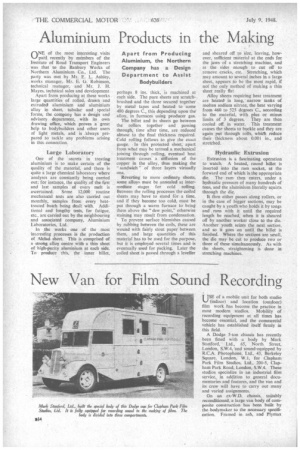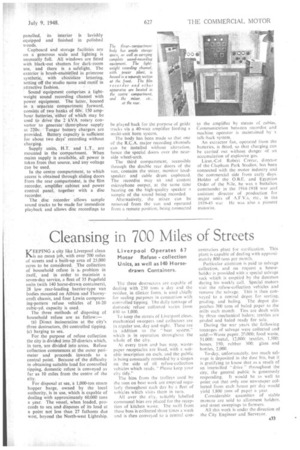New Van for Film Sound Recording
Page 48

Page 51

If you've noticed an error in this article please click here to report it so we can fix it.
VISE of a mobile unit for both studio 1/4--/ (indoor) and location (outdoor) film work has become the practice in most modern studios, Mobility of recording equipment at all times has become essential, and the commercial vehicle has established itself firmly in this field.
A Dodge 5-ton chassis has recently been fitted with a body by Mark Stanford, Ltd., 65, North Street, London, S.W.4, 'and sound-equipped by R.C.A. Photophone, Ltd., 43, Berkeley Square, London, W.1, for Clapham Park Film Studios, Ltd., 201-5, Clapham Park Road, London, S.W.4. These studios specialize in an industrial film service, in addition to general documentaries and features, and the van and its crew will have to carry out many and varied assignments.
On an ex-W.D. chassis, suitably reconditioned, a large van body of composite construction has been built by the bodymaker to the necessary specification. Framed in ash, and Plymax panelled, its interior is lavishly equipped and finished in polished woods.
Cupboard and storage facilities are on a generous scale and lighting is unusually full. All windows are fitted with black-out shutters for dark-room use, and there is a safelight. The exterior is brush-enamelled in primrose synthetic, with chocolate lettering, setting off the studio name and motif in attractive fashion.
Sound equipment comprises a lightweight sound recording channel with power equipment. The latter, housed in a separate compartment forward. consists of two banks of 60v. 150 amphour batteries, either of which may be used to drive the 2 kVA rotary convertor to generate three-phase supply at 220v. Tungar battery chargers are provided. Battery capacity is sufficient for about two days' recording without charging.
Supply units, H.T. and L.T., are mounted in the compartment. When mains supply is available, all power is taken from that source, and any voltage can be used.
In the centre compartment, to which access is obtained through sliding doors from the rear compartment. is the film recorder, amplifier cabinet and power control panel, together with a disc recorder. • The disc recorder allows sample sound tracks to be made for immediate playback and allows disc recordings to be played back for the purpose of guide tracks via a 40-watt amplifier feeding multi-unit horn system.
The body has been made so that one of the R.C.A. major recording channels can be installed without alteration, hence the special doors over the nearside wheel-arch.
The third compartment, accessible through the double rear doors of the van, contains the mixer, monitor loudspeaker and cable drum cupboard. The recordist may sit and control microphone output, at the same time hearing on the high-quality speaker a sample of the .sound being recorded.
Alternatively, the mixer can be removed, from the van and operated from a remote position, being connected to the amplifier by means of cables. Communication between recordist and machine operator is maintained by a talk-back system.
An extractor fan, operated from the batteries, is fitted, so that charging can be carried. out without danger of an accumulation of explosive gas.
Lieut.-Col. Robert Crerar, director of the Clapham Park Studios, has been connected with the motor industry and the commercial side from early days. Holder of the O.R.E. and Egyptian Order of the Nile, he was a battalion commander in the 1914-1918 war and assistant director of production for
major units of etc.. in the 1939-45 war He was also a pioneer motorist.




















































































